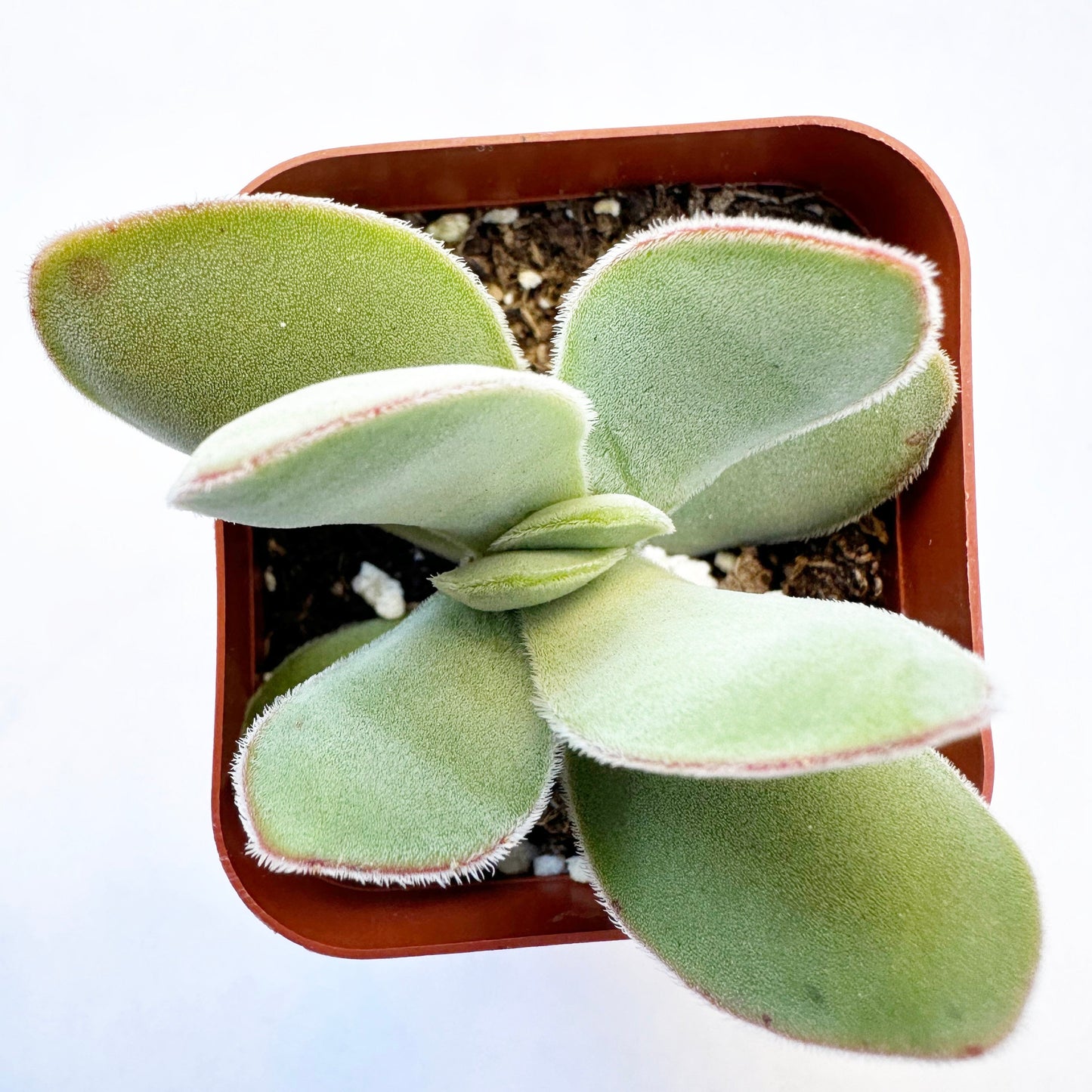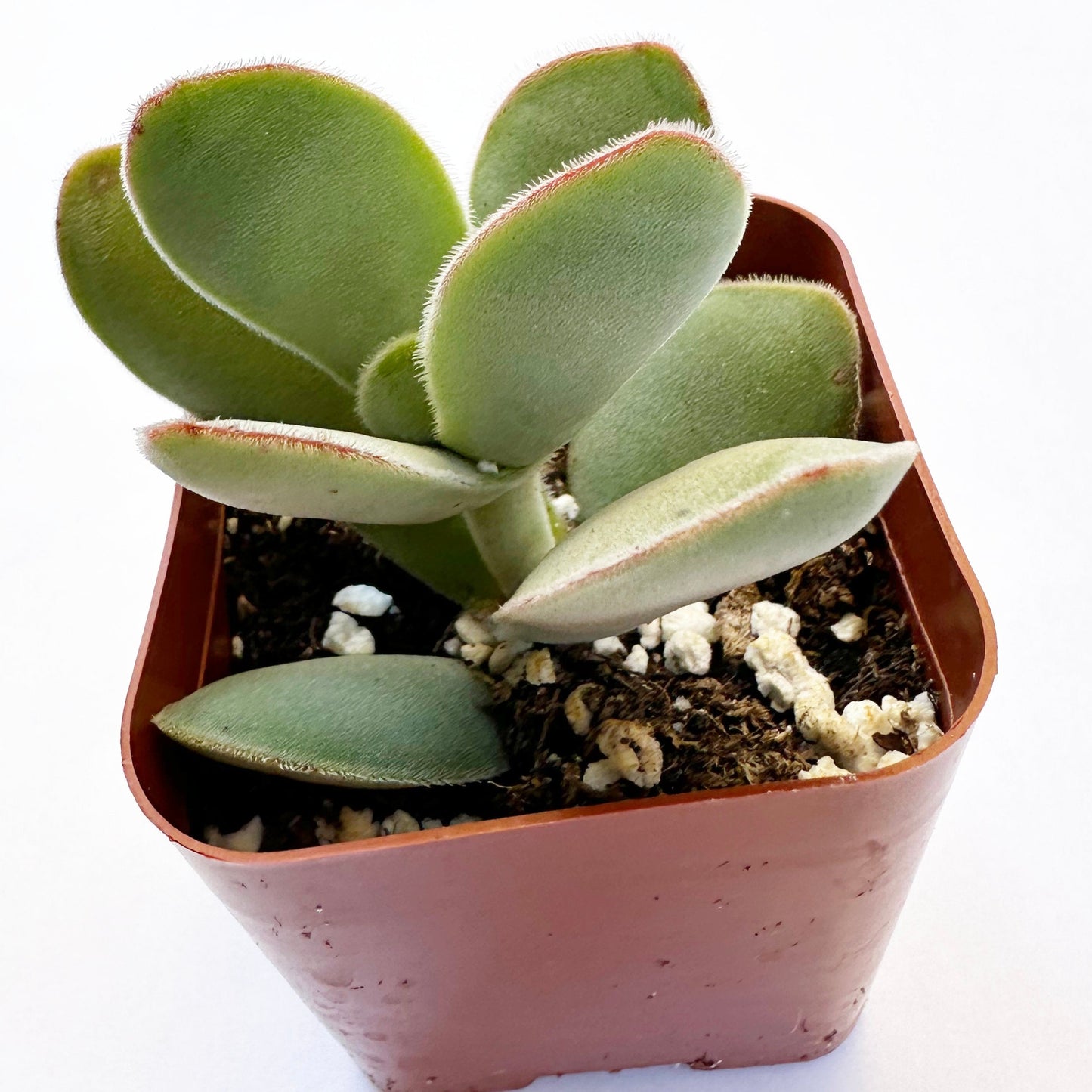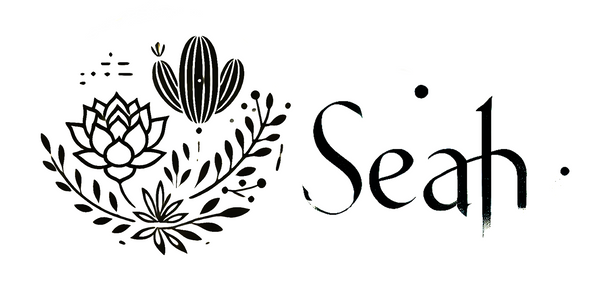Crassula cotyledonis - Dubia
Crassula cotyledonis - Dubia
In stock
Couldn't load pickup availability
📝 Description
Morphological Characteristics
Crassula cotyledonis dubia is a member of the Crassulaceae family, known for its succulent attributes. This plant typically features thick, fleshy leaves that are arranged in a rosette pattern. The leaves are usually green with a slight bluish or silvery tinge and may have red edges if exposed to full sun. The shape of the leaves is broadly ovate with a rounded tip, often exhibiting a waxy or powdery coating which helps in water retention. This species may produce small, star-shaped white or pale pink flowers on erect or slightly leaning inflorescences during the growing season.
Growth Habits
Crassula cotyledonis dubia is a slow-growing succulent that prefers a stable environment. It thrives in mild climates and does not tolerate extreme cold or heat well, making it ideal for growing indoors in temperate regions. In its natural habitat, it tends to grow in rocky or sandy soils which provide excellent drainage.
Maintenance Points
- Lighting: This plant prefers bright, indirect sunlight. While it can tolerate partial shade, too little light may lead to leggy growth and diminished leaf coloration. Direct sunlight can be beneficial but should be limited to avoid scorching the leaves.
- Watering: As a succulent, Crassula cotyledonis dubia requires minimal watering. The soil should be allowed to dry out completely between waterings. Over-watering or allowing the plant to sit in water can lead to root rot.
- Soil: A well-draining succulent or cactus mix is ideal, potentially enhanced with additional perlite or sand to improve drainage.
- Temperature: It does best in temperatures between 15-25°C (59-77°F). Avoid exposure to temperatures below 10°C (50°F) to prevent cold damage.
- Fertilization: Feed lightly with a succulent fertilizer during the growing season; however, too much fertilizer can harm the plant, so it should be done sparingly.
Reproduction Method
Crassula cotyledonis dubia can be propagated primarily through leaf cuttings and offsets. To propagate by leaf cuttings:
- Gently twist a leaf from the stem. Ensure the leaf is intact and not damaged.
- Let the leaf cutting dry for a few days until the cut end forms a callus.
- Place the callused cutting on top of well-draining soil and water sparingly until roots appear.
- Once rooted, the new plant can be treated as an established specimen.
Offsets, or small rosettes that form at the base of the plant, can be carefully removed and replanted in similar soil conditions to grow as new independent plants.
This detailed care and propagation guide should help you maintain and expand your collection of Crassula cotyledonis dubia successfully.
🌿 Care Tips
Plant Care
Light
Water
Soil
Temperature
Hardiness
Fertilizer
Propagation: Leaf/offset cuttings
Common issues: Etiolation, mealybugs, rot
🌟 Note: It’s normal for succulents to appear slightly shriveled after shipping. They usually recover within a few days in a suitable environment.
📦 Shipping Info
Seah Shipping Policy
Effective Date: November 2025
This Shipping Policy applies to orders delivered within the continental United States (the lower 48 states). By purchasing from Seah, you agree to the terms below.
1) Shipping Cost & Free Shipping
- Automatic rate calculation: Shipping is calculated at checkout based on weight, destination ZIP and carrier rates.
- Free Standard Shipping: Orders $59+ (pre-tax, after discounts) ship free to the lower 48 states.
- Alaska, Hawaii, Puerto Rico & other territories: Not eligible for free shipping or standard flat offers at this time.
- Taxes/Duties: Applicable sales tax and any fees are shown at checkout.
2) Processing Schedule
- Business days only: We process and ship Monday–Friday. No shipping on weekends or U.S. federal holidays.
- Handling time: 1–3 business days after payment confirmation.
- Cut-off time: Orders placed before 3:00 PM (PST) are prioritized for same-day processing; others roll to the next business day.
- Changes/Cancellations: Email support@seah.co within 12 hours of purchase; after that, the order may already be in processing.
3) Transit Times
| Method | Estimated Transit | Total ETA (Handling + Transit) |
|---|---|---|
| Standard | 5–8 business days | 6–11 business days |
| Express | 3–4 business days | 4–7 business days |
ETAs are estimates. Weather, holidays, carrier delays or high-volume periods may extend delivery times.
4) Seasonal Temperature & Plant Safety
- Winter (Nov–Mar): We strongly recommend adding a heat pack at checkout to protect plants from freezing. Orders shipped without a heat pack during cold conditions are not covered for cold damage.
- Summer heat: During extreme heat waves, we may hold shipments until temperatures normalize. We’ll notify you if there’s a hold.
- Packaging: Plants are carefully packed (bare-root or potted by type/size) to minimize transit stress.
5) Carriers & Tracking
- We ship via USPS / UPS / FedEx, selected automatically for best service to your address.
- When your order ships, you’ll receive a tracking email. Tracking typically activates within 24 hours.
- If you haven’t received tracking within 3 business days, contact us at support@seah.co or +1 (626)-999-1314.
6) Address Changes & Delivery Issues
- Before shipment: Request address changes within 12 hours of ordering.
- After shipment: We can’t modify the address once dispatched. Please contact the carrier for redirection options.
- PO Boxes: Supported for USPS only; UPS/FedEx require a street address.
- Seah isn’t responsible for delays or loss due to incorrect addresses provided at checkout.
7) Service Area
We currently ship to the continental U.S. (lower 48 states). Orders to AK/HI/PR and other territories are not eligible for free shipping and may be restricted.
8) Support
- Hours: Mon–Fri, 9:00 AM – 5:00 PM (PST)
- Phone: +1 (626)-999-1314
- Email: support@seah.co
- Address: 7870 Margaux Pl, Rancho Cucamonga, CA 91739, United States
Thank you for supporting our California nursery—each plant is hand-selected and packed with care. 🌱




